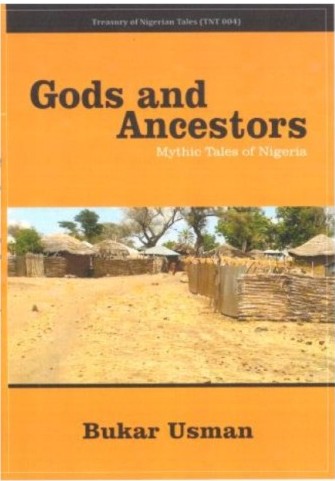|
Mythic Tales, History and Education By Ozolua Uhakheme (The Nation, February 1, 2019)
|
||
|
The torch of folktale awareness drive continues to beam into the nooks and cranies of the Nigerian cultural terrain with the release of another publication, Gods and Ancestors: Mythic Tales of Nigeria (2018) by the Bukar Usman Foundation. The initiative is momentous, as evidenced by the proficiency of contributors. Inputs received from respected professionals and scholars like Chief Tola Adeniyi, Professor Abdu Yahya Bichi, Professor Sani Abba Aliyu, Janet Daniel, George Chijioke, Dawn Zaasi Meneh, Amos Joshua, Mohammed Kabir Azare and other prominent Nigerian culture experts. The very list of contributors, as acknowledged, indicates the seriousness attached to the project and to the promotion, preservation and propagation of Nigerian folklore. In terms of intellectual motivation, the book, Gods and Ancestors, connects with Ulli Beier’s The Origin of Life and Death (1966), which is about African creation myths. Although, unlike the latter, Gods and Ancestors’ coverage area is not continental, but national, it is more intensive, elaborate and detailed. It features creation and cosmic myths, group myths and chronicles, oracular myths and chronicles, legendary heroes and heroines and communal chronicles. Of course, one expects nothing less when the huge population, diversity and vast landmass of Nigeria are taken into account. On the whole, while The Origin of Life and Death contains eighteen tales, Gods and Ancestors, has two hundred and thirteen. Certainly, the quantity of tales does not diminish the profundity of Beier’s pioneering and iconic work. One’s observation is simply aimed at showing the intensity and extensiveness of ways and means resulting in the compilation of the latter. In the opening chapter of the book, stories about the primal beginnings of the examined cultures are presented, especially of how the creator willed the elements, humans and other creatures into existence. It also explains the relationship between the Creator, humans and other creatures. Following this are tales about human habitation of the earth, represented in certain instances by particular settlements. Discretion and indiscretion are accounted for, while the excesses which deny human beings the original benefits of creation are highlighted. Rituals, taboos, guardian spirits and the roles they play in the affairs of humans are equally projected. This is the section containing most of the oral history of ethnic nationalities, like the Tiv who are said to have migrated from Kongo to the Benue basin over a thousand years ago (83). Oracular Myths and Chronicles dwell predominantly on matters spiritual, such as the intercessory role of divinities, deities, priests and priestesses at critical stages in the lives of human beings. ‘The Gods Never Lie’ (97) is about an obstinate king of Ogbuegben who defied the oracle’s order that he should not go to war, but ends up being vanquished and disgraced. Even the frailties of some gods are exposed in this section, either for their hubristic mien or some other tragic flaws. ‘Why the Worshippers of Obatala Do Not Drink Palm-wine’ (110) is one of such tales. Obatala, in Yoruba creation myth is the head of the divinities charged with the responsibility of creating the physical features of humans before God breathes life into it. On a particular day, he was so drunk, his hands were shaky. He ended up moulding human malforms – hunchbacks, the blind, the deaf, the cripple and albino. Under the section on Legendary “Heroes and Heroines”, “The Beautiful Heroine and the Ghost of Atureke” (154) celebrates feminine heroism. There is also the interesting story about ‘ Laoye Farikorun, the First World War Hero’ (157), an indigene of Ilora. There was a mystical side to his person. But he was really a historical figure who fought in World War 1 (1914-1918) and returned to Ilora to continue with his exploits as a man of valour. The last section of Gods and Ancestors is “Communal Chronicles”. Again, one finds aspects of Tiv cultural life (189) quite fascinating here. It provides anthropological explanations to some extant material and creative components of the people’s culture such as the Tiv Hut, the Tiv Dance and the black and white motif of the visually appealing Tiv costume. The same applies to the expository piece on ‘The Installation of a Chief in Gbagyi Land’ (194). As a parting shot, it is necessary to draw attention to the educational import of these tales, especially for the passion with which the older communities preserved records of their past as against the lackadaisicalness of Nigerians today towards their history. Empiricists may raise posers upon the mythic tales, but they remain a vital resource-base in the study of a people’s history and culture. They also constitute a driving force in character moulding – which is why one finds Bukar Usman’s reference to Nelson Mandela’s position most agreeable in this respect. The Madiba states that the stories, legends, myth and fables narrated to him by his mother and aunt introduced him ‘at an early age to the idea of collective effort.’ If one of the greatest leaders of all time says this, what reason has anyone not to measure up culturally? |
||
